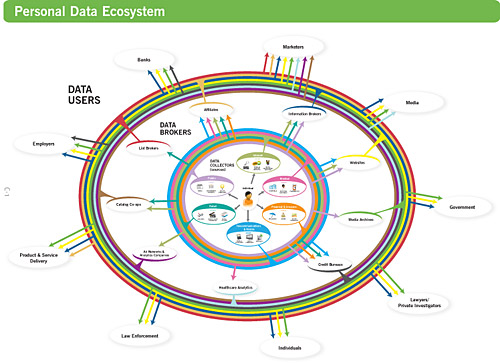The Single Greatest Chart Ever (At Least if You Want to Know Where Your Personal Information Goes)
The Federal Trade Commission (FTC) released a report (PDF) on Wednesday that provides an outstanding start on describing the problems of data collection both on and offline.
Buried in that FTC report is a small gem: On pages 107 and 108 is Appendix C, a chart prepared by technologist Richard Smith which conveys all of the personal information collected about all of us and where it goes.

In concentric circles it explains the information ecology and reminds us that the flow of information about every one of us is largely unregulated.
The inner circle shows all of the entities that collect personally identifiable information on us:
- Public information (such as media, government)
- Retail information (airlines, credit card companies, retail stores)
- Telecommunications providers (the information that cable companies and mobile devices collect)
- Financial information (banks and insurers)
- Medical information (hospitals, pharmacists and doctors)
- Internet information (search engines, websites, social networking)
The middle circle reflects all the entities that collect that particular type of information including information brokers, credit bureaus, websites, healthcare analytics, list brokers and ad networks.
Finally the outer ring is where all those information collectors share that information – the government, employers, marketers, banks, law enforcement and the media.
So, for example, I can look at the chart and see that information from the internet and retailers is shared with information brokers and these brokers in turn share it with the government. Alternatively, I can look and see that information collected by credit bureaus, websites and information brokers are all shared with employers.
Often the ACLU describes its greatest concern as the fear of a surveillance society in which the government can acquire enormous amounts of information about all of us through private companies and as the byproduct of new technologies. Mr. Smith and the FTC have kindly conveyed all of that in a simple chart. We thank them (we think).
Stay informed
Sign up to be the first to hear about how to take action.
By completing this form, I agree to receive occasional emails per the terms of the ACLU's privacy statement.
By completing this form, I agree to receive occasional emails per the terms of the ACLU's privacy statement.


